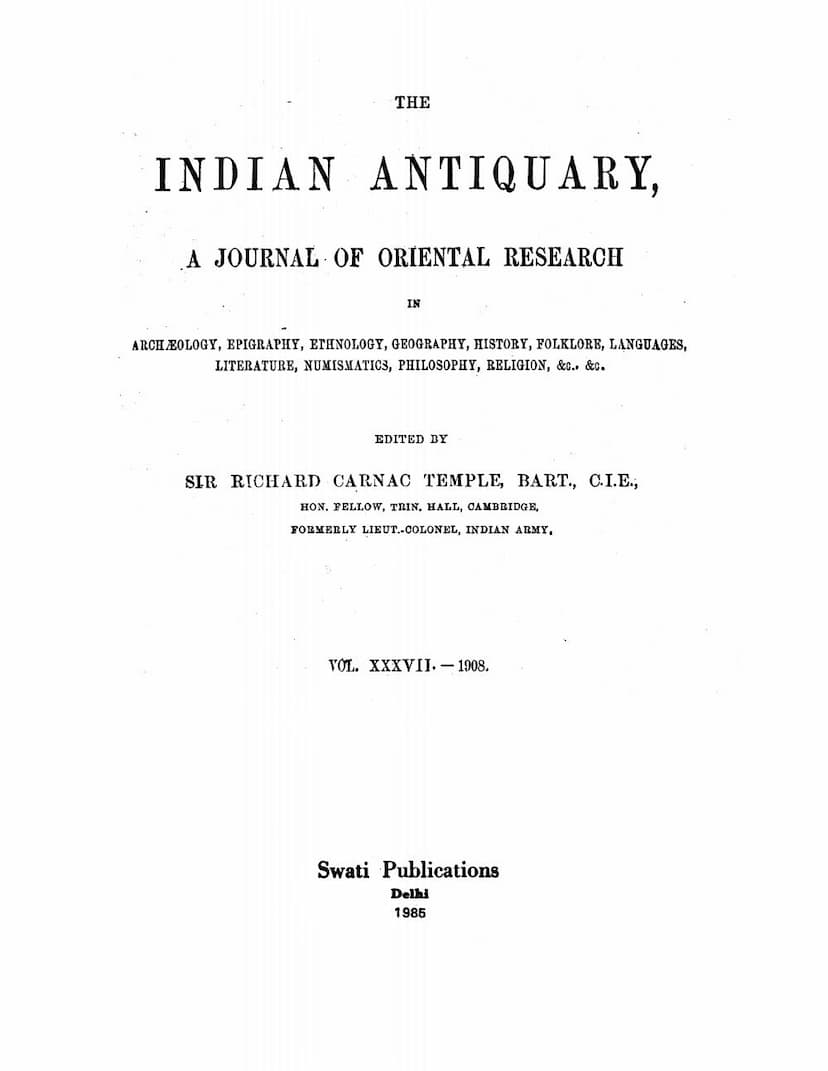Indian Antiquary Vol 37
Added to library: September 1, 2025

Summary
Here's a comprehensive summary of the provided Jain text, based on the content of the Indian Antiquary, Vol. 37 (1908), as it relates to Jainism:
The Indian Antiquary, Vol. 37 (1908), is a collection of scholarly articles on various aspects of Oriental research, including archaeology, history, religion, and literature. While the volume covers a broad range of topics, direct and extensive discussion specifically on Jainism within the provided pages appears to be limited. However, there are several points of indirect relevance or brief mentions that touch upon Jain traditions and historical context.
Key Themes and Mentions Related to Jainism:
-
Comparative Religious Studies: The articles, particularly those discussing the origins and development of religious traditions in ancient India, provide a backdrop against which Jainism can be understood. The article on "The Buddhist Councils" by L. de la Vallée Poussin, for instance, delves into the historical formation of early Buddhist canons and traditions. While the focus is on Buddhism, the comparative analysis of religious practices, disciplinary rules, and the emergence of different sects within Buddhism implicitly highlights the context in which Jainism also evolved and maintained its distinct identity. The mention of "Jaina or Brahmanic" general laws of religious life in the context of asceticism (page 22) suggests a recognition of Jainism as a contemporary and parallel tradition to Buddhism and Brahmanism in ancient India.
-
Linguistic and Epigraphic Evidence: The Indian Antiquary is a primary source for epigraphic studies. While specific Jain inscriptions are not detailed in the provided excerpt, the general discussion on epigraphy, particularly concerning the decipherment and interpretation of ancient Indian scripts like Brahmi and Kharosthi (pages 25-48), is crucial for understanding how Jain texts and inscriptions are studied and dated. The mention of "ancient administrative terms and titles in the Panjab" and "Gazetteer Gleanings in Central India" hints at the broad scope of historical and archaeological research undertaken in the volume, which would undoubtedly include the study of Jain sites and artifacts if they were present in those regions. The inclusion of "List of Brahmi Kușana inscriptions showing archaic forms occurring in them" (pages 37-42) is particularly relevant, as Jain inscriptions often utilize Brahmi script.
-
Historical Periods and Dynasties: The articles on the "Scythian Period of Indian History" by R. D. Banerji and Vincent A. Smith (pages 25-67) and the "History and Coinage of the Chandel Dynasty" by Vincent A. Smith (pages 114-150) place early Indian history within specific dynastic and chronological frameworks. While not directly about Jainism, understanding these periods is essential for contextualizing the historical periods when Jainism flourished and interacted with other contemporary religious and political powers. The mention of the Gupta period (pages 28, 35, 36) and its influence on script and language is indirectly relevant, as Jain traditions and literature were also active during and influenced by this era.
-
Social and Cultural Practices: The descriptions of various customs, such as those related to administrative terms, village organization, and religious practices (pages 76-80, 189-193, 202-207), offer insights into the broader socio-cultural milieu of ancient and medieval India. While these are not exclusively Jain practices, they represent the environment in which Jainism existed and interacted with other communities. The detailed description of oaths and ordeals in Simla Hill States (pages 80) and the mention of various deities and religious practices in the context of the Ramtek temples (pages 202-207) illustrate the diverse religious landscape of India, within which Jainism was a significant component.
-
Specific Mentions (Though Minor):
- In the context of discussing various religious communities and their practices, Jainism is implicitly recognized as part of the religious landscape of ancient India, alongside Buddhism and Brahmanism.
- The meticulous discussion on the "Scythian Period of Indian History" notes the use of Brahmi and Kharosthi scripts in inscriptions, both of which are important for Jain epigraphy.
- The detailed analysis of the "History and Coinage of the Chandel Dynasty" mentions Jain temples and images (pages 118, 120, 134, 137), indicating the presence and patronage of Jainism during the Chandel rule.
- The article on "A Visit to Ramtek" mentions a "Jaina temple" and "Jaina images" (page 204), suggesting the historical presence of Jainism in that region. The local Jainas' tradition connecting Rama with their persuasion and his worship of Santi Natha is also noted.
In summary, while the provided text from the Indian Antiquary, Vol. 37 (1908) does not feature a dedicated article on Jainism, it offers a rich tapestry of historical, linguistic, and religious information about ancient and medieval India. This broader context is valuable for understanding the historical environment in which Jainism developed and interacted with other major religious traditions. The mentions of Jain temples, script usage, and the general comparative religious studies provide indirect but important connections to the study of Jainism within the Indian subcontinent.